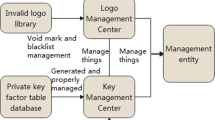Abstract
Supply chain management is of great significance to business operations and socioeconomic development. However, the current supply chain efficiency management cannot effectively control the risk caused by the inefficient supply chain management. In order to study the improvement in supply chain efficiency management, supported by machine learning and neural network technology, this study builds a supply chain risk management model based on learning and neural network. Moreover, this study evaluates the risk indicator system based on the current status of supply chain management. In addition, the model simulation research is carried out in the MATLAB platform, and the validity analysis of the model is performed with examples. Finally, after training the data through the training model, the risk assessment value is output, and strategies for coping with the risk are given. The research shows that the model proposed in this paper has a certain practical effect and can be considered for application.















Similar content being viewed by others
References
Turkulainen V, Swink ML (2017) Supply chain personnel as knowledge resources for innovation—a contingency view. J Supply Chain Manag 53(3):41–59
Luo T, Yu J (2019) Friends along supply chain and relationship-specific investments. Rev Quant Finance Account 53(3):895–931
Gholamian MR, Taghanzadeh AH (2017) Integrated network design of wheat supply chain: a real case of Iran. Comput Electron Agric 140:139–147
Bahemia H, Squire B, Cousins P (2017) A multi-dimensional approach for managing open innovation in NPD. Int J Oper Prod Manag 37(10):1366–1385
Zhalechian M, Tavakkoli-Moghaddam R, Rahimi Y et al (2017) An interactive possibilistic programming approach for a multi-objective hub location problem: economic and environmental design. Appl Soft Comput 52:699–713
Tan KH, Ali MH, Makhbul ZM et al (2017) The impact of external integration on halal food integrity. Supply Chain Manag 22(2):158–164
Georgiadis G, Tang CS (2017) Project contracting strategies for managing team dynamics. Handbook of information exchange in supply chain management. Springer, Cham, pp 89–105
Evanschitzky H, Goergen M (2018) Looking forward, looking back: British Journal of Management 2000–2015. Br J Manag 29(1):3–9
Preston DS, Chen DQ, Swink M et al (2017) Generating supplier benefits through buyer-enabled knowledge enrichment: a social capital perspective. Decis Sci 48(2):248–287
Zijm H, Klumpp M, Clausen U et al (2015) Logistics and supply chain innovation. Springer, Berlin
Kolben K (2014) Dialogic labor regulation in the global supply chain. Mich J Int Law 36:425
Wu G, Siew CK (2004) Integrated production and transportation scheduling in supply chain optimisation. Recent advances in simulated evolution and learning, pp 406–425
Staniek M, Sierpiński G (2016) Smart platform for support issues at the first and last mile in the supply chain-the concept of the s-mile project. Zeszyty Naukowe. Transport/Politechnika Śląska 92:141–148
Rola R (2016) ISO 14001 certification a step ahead towards implementation of green supply chain management practices in chemical industries. Kvant Electron 17(19):399–401
Govindan K, Soleimani H, Kannan D (2015) Reverse logistics and closed-loop supply chain: a comprehensive review to explore the future. Eur J Oper Res 240(3):603–626
Lu W (2015) A cost–benefit analysis of construction and demolition waste management throughout the waste chain. In: Regional 3R Forum in Asia and the Pacific. United Nations
Erkmen E, Hancer M (2015) Linking brand commitment and brand citizenship behaviors of airline employees: “The role of trust”. J Air Transp Manag 42:47–54
Mes MRK, Iacob ME (2016) Synchromodal transport planning at a logistics service provider. Logistics and supply chain innovation. Springer, Cham, pp 23–36
Juan AA, Kelton WD, Currie CSM et al (2018) Simheuristics applications: dealing with uncertainty in logistics, transportation, and other supply chain areas. In: 2018 winter simulation conference (WSC). IEEE, pp 3048–3059
Taha A, Hachimi M, Moudden A (2017) A discrete Bat Algorithm for the vehicle routing problem with time windows. In: 2017 International colloquium on logistics and supply chain management (LOGISTIQUA). IEEE, pp 65–70
Kim SH, Cohen MA, Netessine S (2017) Reliability or inventory? an analysis of performance-based contracts for product support services. Handbook of information exchange in supply chain management. Springer, Cham, pp 65–88
Reitsma E, Hilletofth P, Mukhtar U (2018) Enterprise resource planning system implementation: a user perspective. Oper Supply Chain Manag 11(3):110–117
Acknowledgements
The study was supported by China National Social Science Foundation Project (19CJY047), Heilongjiang Philosophy and Social Science Research Planning Project (18JYC259).
Author information
Authors and Affiliations
Corresponding author
Ethics declarations
Conflict of interest
The authors have no competing interests.
Additional information
Publisher's Note
Springer Nature remains neutral with regard to jurisdictional claims in published maps and institutional affiliations.
Rights and permissions
About this article
Cite this article
Han, C., Zhang, Q. Optimization of supply chain efficiency management based on machine learning and neural network. Neural Comput & Applic 33, 1419–1433 (2021). https://doi.org/10.1007/s00521-020-05023-1
Received:
Accepted:
Published:
Issue Date:
DOI: https://doi.org/10.1007/s00521-020-05023-1




